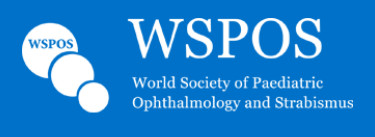Education
Case Report: Case 20
Case Presenters
Dr. B. Venkateshwar Rao pursued his Ophthalmology training at the R.P. Center, All India Institute of Medical Sciences (AIIMS), New Delhi; following which he underwent a fellowship in Strabismus and Neuro-Ophthalmology under Prof. Prem Prakash from the same institute. He then went on to do a 2nd Fellowship in Pediatric Ophthalmology & Strabismus under the tutelage of Prof. Eugene Helveston from the Indiana University Medical Center, Indianapolis, USA.
Dr. Rao is a specialist in Pediatric Strabismus, Adult Strabismus and Neuro-Ophthalmology. In addition to his fellowship training, he also visited various Hospitals in the USA. He served as Head of the Pediatric Ophthalmology, Strabismus and Neuro-Ophthalmology service at L. V. Prasad Eye Institute, Hyderabad, India right from the unit’s inception in January 1998 and was with L. V. Prasad Eye Institute till February 2006. With his vast clinical and academic experience, Dr. Rao started Shreya Eye Care Center in March 2006 with a mission of providing quality care with compassion in the field of Strabismus, Pediatric eye problems and Neuro-Ophthalmology and is presently the Director of the same. He is a present and past member of several
prestigious international organizations including AAO, AAPOS, ISA, AIOS, SPOSI, WSPOS & APAO. Dr. Rao has lectured at various Universities in India, USA, Indonesia, Sri Lanka & Bangladesh, covering several topics of Strabismus, Amblyopia, Congenital Cataract and Neuro-Ophthalmology in addition to having published articles in peer reviewed international journals and presented at various international meetings such as AAO, AAPOS, ESA, ISA, WSPOS, APAO & IOA.
Dr. B. Venkateshwar Rao has sent us Case 20
Status: CASE CLOSED
Members’ Responses:
1) When our members were asked ‘How would you address the issue of diplopia in this case?’
54.55% said they’d opt for Eye Muscle Surgery, 2.27% would use Prisms, 31.82% said they’d go for Surgery + Prisms & the remaining 11.36% said they’d opt for Botox + Prisms at this juncture.
2) When they were asked ‘If You Would Operate, What Procedure Would You Choose?’
While 12% of our members said they would perform an MR Recession in Both Eyes, 80% said they’d opt for Both Eyes MR + Right Eye IR Recession & the remaining 8% would perform an MR Recession in Both Eyes + One Eye LR Resection + Right Eye IR Recession.
3) When our members were asked ‘What would you do further for his diplopia?’
59.09% opted to perform an Additional Surgical Procedure, 31.82% said they’d inject Botox to the MR, 9.09% would use Prisms. However, none of our members opted for ‘No Further Surgery / Using a Frosted Glass Over One Eye’.
.
Experts Opinion
1) How would you address diplopia in this case?
2) If you would operate, what procedure would you choose?
3) What would you do further for his diplopia?
4) Would you opt for adjustable or fixed suture surgery? Why?
5) What, according to you, is the role of transposition of IR muscle while recessing it?
6) What is the role of traction test for obliques?
7) Would you weaken the SO if you are doing a bilateral IR recession to prevent A pattern?
8) Do you take into account late overcorrection after IR recession, especially in adjustable surgery?
9) Would you use Vicryl or non-absorbable sutures for the inferior rectus?
10) What is your response per mm of recession in tight thyroid muscles?
Daniel Salchow

Daniel Salchow is Professor of Ophthalmology & is the Director of the section for Pediatric Ophthalmology, Strabismus and Neuroophthalmology at the Department of Ophthalmology,
Charité-University Medicine Berlin, Germany. He cares for children with all types of vision and eye problems. Dr. Salchow received his M.D. degree from the University of Lübeck Medical School in Germany and trained at Lenox Hill Hospital, New York City (internship), the Edward S. Harkness Eye Institute, Columbia University, New York (residency), and Children’s National Medical Center, Washington, DC (fellowship). From 2007 – 2012, Dr. Salchow was the director of pediatric ophthalmology and strabismus service at the Department of Ophthalmology of Yale University in New Haven, CT.
Dr. Salchow is a board-certified ophthalmologist in the USA and Germany. His areas of special clinical interest and expertise include cataracts in children (including complex cases such as
dislocated lenses in Marfan syndrome) and the correction of strabismus in children and adults. His research focuses on the use of optical coherence tomography (OCT) for children’s eye problems, the treatment of strabismus and the prophylaxis of after-cataract in children.
Dr. Salchow has published numerous scientific articles, several book chapters, an onlinechapter on strabismus and has given many invited lectures internationally. He received the “Excellence in Teaching Award” of the Yale Ophthalmology Residency program in 2009.
1) How would you address diplopia in this case?
I would perform eye muscle surgery. Prisms (e.g. Fresnel prism foils, as they may be temporary) may be needed for residual diplopia postoperatively. See my responses to Q 10 for a more detailed discussion of this case.
2) If you would operate, what procedure would you choose?
I would do a bilateral medial rectus muscle recession and a right inferior rectus muscle recession.
3) What would you do further for his diplopia?
I recommend additional surgery, because the improvement is not satisfactory.
4) Would You Opt for Adjustable or Fixed Suture Surgery? & Why?
I would perform fixed sutures. This is my personal choice based on previous experiences. I feel that the postoperative shift may be hard to predict, especially in patients with thyroid-related orbitopathy (TRO) and the tightness of extraocular muscles in these patients can make adjustments technically difficult and may increase the risk for slippage in patients with more severe disease.
5) What According to You (if any) is the Role of Transposition of IR Muscle While Recessing it?
When recessing the inferior rectus, one has to be careful to not place the muscle too far nasally. This is particularly important in large recessions (5 and more mm). I place the muscle straight behind its insertion (not along its course, which would result in a nasal transposition). In my experience, this can effectively prevent symptomatic A-patterns in most patients.
6) What is the Role of Traction Test for Obliques?
In patients with severe strabismus from TRO, I find the traction test for oblique muscles hard to interpret, because passive motility (particularly abduction and elevation) is often markedly restricted.
7) Would you Weaken the SO if you are doing a bilateral IR recession to prevent A Pattern?
No
8) Do You Take into Account Late Overcorrection After IR Recession, Especially in Adjustable Surgery?
Yes, one needs to explain this to the patient. Particularly in patients with TRO in whom one recesses one inferior rectus muscle, the likelihood that a recession of the contralateral inferior rectus will be required in the future is relatively high.
9) Would You Use Vicryl or Non Absorbable Sutures for the Inferior Rectus?
Despite the concern for inferior rectus slippage, I have used and continue to use 6-0 vicryl sutures. In my experience, this phenomenon is rather rarely encountered in TRO patients. However, it curiously occurs slightly more often in non-TRO patients (in whom I still use vicryl, except for reops after slippage).
10) What is Your Response to Per mm of Recession in Tight Thyroid Muscles?
As a starting point, I use my regular tables and estimate 3 prism diopters per mm recession of the inferior rectus and about 2-3 prism diopters per mm recession of the medial rectus. However, it is important to keep in mind that these numbers often need to be modified in patients with strabismus secondary to TRO. I use the “intraoperative relaxed muscle positioning technique” as described by Dal Canto et al., (Ophthalmology 2006), where one allows the disinserted muscle to rest freely on the globe with the globe positioned so that its anteroposterior axis is perpendicular to the frontal plane (primary position for practical purposes). This is the position to suture the muscle to the globe.
A few more comments on the case at hand: Before one performs eye muscle surgery on patients with TRO, one needs to make sure that the orbital inflammation is inactive (preferably for several months) and that the misalignment is stable. It is my impression, that there may still be some activity (injected conjunctiva) in this patient. To assess for activity of TRO, the clinical activity score (CAS), a scheme that incorporates subjective symptoms and clinical findings (https://www.thyroid.org/wp-content/uploads/2012/04/Graves_Opthalmopathy.pdf), can be recommended. If the patient has active TRO, I prefer pulsed corticosteroids administered intravenously weekly (e.g. methylprednisolone 500 mg IV weekly for 6 weeks, followed by 250 mg IV weekly for 6 weeks). I typically check patients after 6-8 weeks and after they finish the 12-week course. Pulsed IV steroids have been shown to be more effective with lesser unwanted side effects than oral steroids. In patients in whom activity (according to the CAS) persists, orbital radiation or a second course of pulsed IV steroids are my first choice. Recently, biologic agents (rituximab, teprotunumab) have shown to be effective in patients with active TRO and their role may become more important is we learn more about these drugs.
Dominique Thouvenin

Dr. Dominique Thouvenin was Born in Paris, in 1957 & completed his Medical studies in Paris. He then went on to
pursue a Residency (Ophthalmology) from Toulouse & followed it with a Fellowship (PO&S) in Toulouse and Nantes (Pr
Quere). Dr. Thouvenin has a Private practice in Toulouse and has been a consultant surgeon in Toulouse University
Hospital from 1992, with an exclusively surgical pediatric ophthalmology and strabology practice. He is also a teacher at the Toulouse Orthoptic school, French University Diploma of Strabology and Pediatric ophthalmology.
Besides being an active member of the French Society of Ophthalmology, Dr. Thouvenin has Co-authored both Pediatric
ophthalmology (2017) and Strabology (2013) books for the society. He has been a former secretary of French associationof PO&S. (AFSOP). Former Vice President of European Strabismological Association. Member of AAPOS, ISA, and WSPOS. Member of IPOSC for AFSOP representation. Field of works and publications since 1990: Deprivation amblyopia, Infantile cataracts, Infantile Strabismus, strabismus surgery in general, and more precisely in Infantile strabismus, Botulinum Toxin, Adult strabismus, high Myopia, Oblique muscle surgery. He still makes time for hobbies that he shares with his children and friends He is a musician who loves mountains, sailing & hiking.
1) How would you address diplopia in this case?
I would go to surgery and hopefully no prisms IF:
• The clinical activity score (CAS) is under 3
• If the no other treatment options are discussed (medical treatment, other orbital surgery) which is probably the case
• And if possible with the results of a T2 orbital MRI showing no activity of the disease
2) If you would operate, what procedure would you choose?
I would perform Bi medial recession, and Right Inferior Rectus recession. Patient warned of a possible second surgery if the results is not optimal, usually at least 6 months later.
3) What would you do further for his diplopia?
• I would wait at least 6 months because the surgical procedure is already quite strong and results may improve with time. And once again, if possible have an MRI to see the state of all muscles
• And then propose a second surgical step
• I think botulinum will not have a spectacular effect one those fibrotic muscles (at this stage of the illness)
• 50 PD esotropia means a very large prism with no visual comfort
4) Would You Opt for Adjustable or Fixed Suture Surgery? & Why?
No, although I use them in the large majority of adult strabismus. It has been shown that there is more frequently a secondary overcorrection avec adjustable surgery in this condition (TED) than with conventional surgery
5) What According to You (if any) is the Role of Transposition of IR Muscle While Recessing it?
I totally agree, because it improves effect of IR recession on vertical gaze, and it helps decreasing excyclotorsion, especially in upgaze. I usually perform a simple 3 mm nasal transposition.
6) What is the Role of Traction Test for Obliques?
It is important and I use it routinely for SO palsy or other oblique surgery. But I think these tests may be difficult to analyse when there is a global fibrosis of intra orbital tissues.
I use rotary test modified by Holmes (Mendes ring) and Guyton test
7) Would You Weaken the SO if You Are Doing a Bilateral IR Recession to Prevent A Pattern?
I did not have to use it in TED EOM surgery. I routinely use them in SO palsy surgery or other torsional or oblique illnesses.
I think that it is less sensible when all the right muscles are fibrotic and all the more when all the orbital tissue is involved.
8) Do You Take into Account Late Overcorrection After IR Recession, Especially in Adjustable Surgery?
Yes, and this is why I don’t use it anymore. Very difficult to tune the second surgery on vertical deviation
9) Would You Use Vicryl or Non Absorbable Sutures for the Inferior Rectus?
Vicryl. I tried adjustable suture with non-absorbable suture without better post op stability, and more difficulties when I went back on it. Very few experience so, I don’t think my advice is interesting in this specific question.
10) What is Your Response to Per mm of Recession in Tight Thyroid Muscles?
I exactly follow the lack of elongation of the muscle with good results, rarely more than 8 mm on MR, and 6 on IR. I did not calculate the rate of response per mm.
Silvia Moguel-Ancheita

Dr. Silvia Moguel-Ancheita is a Strabismologist, Ophthalmological Doctor, Master in Neurosciences & a
Master in Research Ethics. While Dr. Moguel-Ancheita’s Master in Neurosciences is from the Pablo De
Olavide University, Spain, her Masters in Research Ethics, Third Level is from the University of Hong
Kong. She is the High Specialty Headline Professor in Strabismus at the Universidad Autonoma De
Mexico, in addition to being a Professor of Neurostimulation and Neurofacilitation at the Sociedad
Mexicana De Pediatria. She is also the Ex-President of the Centro Mexicano De Estrabismo, the Current
Counselor of Centro Mexicano De Estrabismo & is also a Member of the International Strabismological
Association. She is also a Member of the European Strabismological Association, in addition to being a
Member of Consejo Latinoamericano De Estrabismo. Dr. Moguel-Ancheita is the Coordinator of the
Amblyopia Commission & also Heads the Amblyopia Campaign. She is a Member of the Panamerican
Ophthalmology Association, & has been Heading the Strabismus Department for the past 20 Years at the
National Medical Center “20 De Noviembre”, Issste. She is a Member Certified by the Mexican Council of
Ophthalmology, in addition to being the Revisor of the Archivos Magazine of the Spanish Society of
Ophthalmology. Dr. Moguel-Ancheita is a Member and Revisor of the Editorial Committee of the
Mexican Journal of Ophthalmology & has more than 432 Papers, 230 Courses, 84 Publications, 20 Thesis
Advisor, 6 Magistral Conferences & even 4 Honorary Mentions.
1) How would you address diplopia in this case?
Eye Muscle Surgery
I can see that it is a case with exophthalmos and significant eye movement restriction, despite having undergone a decompression operation. In the images I can still see signs of inflammatory activity, however I must assume that the activity has already been verified through autoimmune tests and antibody levels, because only under autoimmune stability I would decide the surgery for strabismus. If not, and the patient persists in the autoimmune active phase, I would prefer treatment with botulinum toxin.
2) If you would operate, what procedure would you choose?
Both eyes MR + right IR recession
As normally occurs, the inferior and medial rectus muscles are the most common of affectation in thyroid disease; although the degree of infiltration may be occurring asymmetrically and irregularly even in all muscles, it is more common to observe hypotrophies and esotropias. It is also one of the most frequent strabismus after decompression surgery. And since the most common cause is related to a greater tension of these, the initial indication is to weaken them, which is why I prefer the bilateral weakening of both medial rectus and to initially add the recession of the right inferior rectus, taking into account that the left one may require it in another time.
3) What would you do further for his diplopia?
Additional Surgical Procedure
As we can see, surgery in thyroid strabismus, even when planned correctly, may not have the expected response. It must be considered that strabismus, in this case, is caused by all orbital disorders, including the posterior tissues, that impede the good functionality of the muscles, as well as the structural loss of the muscle fibre, damaging both its elasticity, its contractile force, and even the loss of affected tendon supports after decompression, etc. So we have to re operate. Either to add further weakening, if we can see that the previous was not enough, or even to consider the resection of the lateral rectus, which can be evaluated with topical anaesthesia.
4) Would You Opt for Adjustable or Fixed Suture Surgery? & Why?
The final result in this case is extremely good and demonstrates the possibility of the use of reinforcement techniques that are normally less recommended in surgery for thyroid strabismus. Personally, I prefer to do the second surgery under topical anaesthesia, trying to make it a little undercorrected. Doing the surgery under topical anaesthesia is a good procedure to evaluate the muscle function, allows observing the immediate effect when the muscle has been removed and it also allows evaluating the final position and the effect on the entire strabismus.
I would not have done fixing techniques.
5) What According to You (if any) is the Role of Transposition of IR Muscle While Recessing it?
I agree on transposition of the inferior recti when they are tense and this can bring improvement over the horizontal deviation; I have used it especially in cases of congenital fibrosis of both inferior rectus as in CFEOM type I.
6) What is the Role of Traction Test for Obliques?
I consider that the traction test for oblique muscle examination is not useful in this case since the posterior restrictions generated by the inflammatory and fibrous process do not allow us to adequately evaluate the eyeball rotation manoeuvres to identify the action of the oblique muscles, and which is, on the contrary, very useful in other pathological entities.
7) Would You Weaken the SO if You Are Doing a Bilateral IR Recession to Prevent A Pattern?
I think that weakening of both inferior rectus muscles, especially when they are fibrous or tense, as in CFEOM type I can cause a secondary A pattern, that is why I add the simultaneous transposition. In one case of CFEOM type I, operating under topical anaesthesia, I simultaneously performed the weakening of the both superior obliques demonstrating the little effect on the divergence, that is why I consider that the displacements during the recession of both inferior rectus muscles is sufficient.
8) Do You Take into Account Late Overcorrection After IR Recession, Especially in Adjustable Surgery?
Yes, we should always keep in mind the possibility of late overcorrection after inferior rectus recession, especially in monocular surgery, which is why I always prefer to leave little undercorrection. When we leave the patient with a minimal hypotropia, we can see that in a few months it has been corrected, which is preferable to leaving it in a good orthotropia at the beginning, but then possibly later having an overcorrection.
9) Would You Use Vicryl or Non Absorbable Sutures for the Inferior Rectus?
I always use non-absorbable sutures when I operate a highly tense inferior rectus muscle and try to ensure adequate and secure fixation to the sclera; and generally I also use more tendon for my suture compared when I operate a normal tension muscle.
10) What is Your Response to Per mm of Recession in Tight Thyroid Muscles?
The response for each mm of muscular recession in thyroid strabismus is generally increased, especially when the test shows a tight muscle, so I always prefer to do every time a small amount of recession, especially when operating inferior rectus muscles, so we can correct an important amount of strabismus no related with the minimum of the recession, for example. To know how much recession I should do, I do traction tests with the sutures and check to decrease the tension with the least recession.
But I think that this is not the case anymore when the orbital infiltrative process is more severe on the non-muscular posterior tissues, fat, etc., since this generates a more generalized restriction of the eyeball and the response to muscular surgery is no longer the common one; or as this case, the natural fixation and support of muscles tissues has been lost because of the previous decompression surgery, it is when, despite doing a good recession, the residual strabismus is still important, or even sometimes like we haven’t done anything, and that is when we have to especially consider the need to perform combined techniques, such as adding botulinum toxin injection in the muscle to be recessed at the same time of surgery, or even, as in this case, the need to do the resection of the opposing muscles.
Steven Archer

Dr. Steven Archer was an undergraduate in computer science at the University of Utah, attended medical school at the University of Chicago and did a postdoctoral fellowship in developmental neurobiology at the University of Colorado. His ophthalmology residency was back at the University of Chicago and he did a pediatric ophthalmology fellowship at Indiana University with Eugene Helveston and Daryel Ellis. Dr. Archer joined the faculty at the University of Michigan over 30 years ago where he is the Ida Lucy Iacobucci Collegiate Professor. Dr. Archer’s research interests have included infant motor and sensory visual development and physiological optics. His clinical interests have included retinopathy of prematurity, retinoblastoma, pediatric glaucoma and pediatric cataracts. His current clinical activity has an emphasis on complicated adult strabismus.
1) How would you address diplopia in this case?
Eye muscle surgery, but this patient’s decompressions are not optimal in the context of current decompression techniques, so I would want him adequately decompressed first.
2) If you would operate, what procedure would you choose?
Medial rectus recession in both eyes and right inferior rectus recession.
3) What would you do further for his diplopia?
Additional surgery—I would do bilateral lateral rectus resections, which have been very useful to me with undercorrected esotropia in Graves eye disease, and re-recess either medial rectus muscle if significant residual restriction is found on forced duction testing.
4) Would you opt for adjustable of fixed suture surgery? Why?
Yes, especially for the inferior rectus recession in the first surgery and the lateral rectus resections in the second surgery. Inferior rectus recessions in Graves eye disease can be unpredictable and there is a reliable goal for adjustment on the day of surgery. Lateral rectus resections with residual esotropia after adequate medial rectus recessions in Graves eye disease are also unpredictable; usual amounts of resection can be fine, but some patients will have a large over-correction with this.
5) What, according to you, is the role of transposition of IR muscle while recessing it?
Nasal shift of the inferior rectus could have a small beneficial effect on any A pattern but also make intorsion worse. On balance, I don’t think it makes much difference. I usually shift the inferior rectus to the nasal side of its normal insertion; since this is usually a “hang-back” technique for adjustable suture, this probably does little more than keep the recessed muscle in its normal path as it courses nasally toward its origin at the orbital apex.
6) What is the role of traction test for obliques?
I find it hard to do a meaningful superior oblique traction test on Graves eye disease patients, who have a lot of miscellaneous restriction and are often elderly with tenuous conjunctiva. I have not found it helpful in determining whether SO tenotomies are needed.
7) Would you weaken the SO if you are doing a bilateral IR recession to prevent A pattern?
The best way to avoid A pattern and intorsion in reading position is to not recess both inferior rectus muscles. If one absolutely has to do both (rare in my experience), many will do fine. So I prefer not to do SO tenotomies, which are not very reversible, until I see the results of the initial to know for sure whether they are needed. When a problematic A pattern and intorsion in down gaze develop, SO tenotomies are sometimes not enough to adequately address these problems.
8) Do you take into account late overcorrection after IR recession, especially in adjustable surgery?
Yes, I always leave these patients undercorrected on the day of surgery. Fusing with a 10-degree chin-up head posture has been a good adjustment point.
9) Would you use Vicryl or non-absorbable sutures for the inferior rectus?
I always use Vicryl whether adjustable or not. In my cases of overcorrection where I have returned to the inferior rectus muscle, I have never seen a stretched scar or found the muscle more posterior than I expected; often they are actually a little more anterior than expected.
10) What is your response per mm of recession in tight thyroid muscles?
The result I get from a given amount of recession, especially inferior rectus, depending on the mechanics of each muscle, can be so different that it isn’t useful to think about the response in terms of prism diopters per mm of recession.

